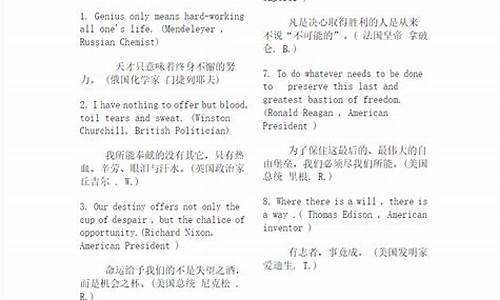句子复数的英语怎么读_句子的复数的英文
1.英语句子变复数,怎么做,谢谢!
2.怎样判断英语句子中的单复数
3.a pair of是单数还是复数?后面的名词加不加s?句子是用is还是are?
4.英语句子变复数,只用变复数就可以了,不要多

单数句变复数句
默认分类 2010-10-06 18:48:57 阅读127 评论0 字号:大 中 小?订阅
1.人称代词单数变成相应的人称代词复数 ,即
a 主格 :I→we;you→you;she/he/it→they。
b 宾格 me →us you→you her/him/ its→them。
如:She is a girl.→ They are girls.
2.物主代词由单数变成相对应的复数, 即
a, 形容词性物主代词 :my→our ; your→your; his/her/its→their.
b 名词性物主代词 :mine→ours;yours→yours; his/hers/its→theirs.
3. be动词:am is变为are 。
如:I'm a student. →We are students.
4.不定冠词a an 表示“一个”,只能用在单数句中,当变成复数句时,一定要把aan去掉
或改为 some/any。
如:He is a boy. → They are (some) boys.
5.普通单数名词要变为复数形式。
如:It is a cat. →They are cats.
6.指示代词 由单变复。即this变为these;that 变成those 。
如:This is a book.→ These are books.
7.man woman 作定语修饰可数名词时,要在"数"上与被修饰名词保持一致。但其他名词
修饰名词表示"性质"时,不作变化。
如:He is a man doctor.→They are men doctors.
This is an le tree.→They are le trees.
8. 一般情况下,形容词性物主代词在单数句变成复数句时不变。
如:This is my pen.→These are my pens.
9. 当句中形容词性物主代词与句中的主语一致时,该物主代词应随主语人称的变化而变化,仍要保
持一致。
如:He likes his bike.→They like their bikes.
10. 单数句变成复数句时,句式不能变。即单数句是疑问句时,变成复数句时仍然是疑问句。
如:What's this?→What are these?
※记住单数句变复数句的口诀。
单数句子变复数,变化规则要记住。
名词代词要变化,am is 要变are。
this that 该咋办,these those 替代它。
he she it 要变啥,全部变 they 就行了。
I要变 we 别落下,名词后面把 s/es加。
名前冠词去掉它,其余成分原样加。
但是,在英语中有些单数句不能变为复数句,如:Lily is four.(莉莉十四岁。)His name is Jim.(他的名字叫吉姆。)等。
顺顺当当
英语句子变复数,怎么做,谢谢!
1、第一人称单数变一般疑问句,把系动词am变成are放到句首,把I变成you。
2、第二人称或其他复数人称,直接把系动词are放到句首。
3、第三人称单数形式变一般疑问句,把系动词is放到句首。
一、am
读音:英 [?m]? 美 [?m]?
释义:是。
语法:be的第一人称单数现在式;口语中常略作’m。
二、are
读音:英 [ɑ?(r) , e?(r)]? 美 [ɑ?r , er]?
释义:是。
语法:be的第二人称单复数现在时,第一、三人称复数现在时。
三、is
读音:英 [?z]? 美 [?z]?
释义:是。
语法:be的第三人称单数现在时形式,常放在其他词后缩写为 -’s。
扩展资料一般疑问句是疑问句的一种。它是一般只用yes(是)或no(否)来回答的句子。朗读一般疑问句时用升调,而一般疑问句的简略答语则用降调。
1、第一家族为含be动词或情态动词的一般疑问句,其结构为:
(1)be + 主语 + 其它部分
(2)情态动词 + 主语 + 动词原形 + 其它部分
肯定回答用“Yes,主语+be\情态动词.”,否定回答用“No,主语+be\情态动词+not.”。be或情态动词和not可用缩写形式,主要有isn’t,aren’t,wasn’t,weren’t,can’t,mustn’t,needn’t等。
2、另一家族为含行为动词(或称为实义动词)的一般疑问句,其结构为:
助动词 + 主语 + 动词原形 + 其它
肯定回答用“Yes, 主语+ do\does.”,否定回答用“No, 主语+do\does not.”。助动词也常用缩写形式,主要有don’t,doesn’t,didn’t等。
怎样判断英语句子中的单复数
1.these are our books.
2.those are their families.
3.they are french.
4.we are students.
5.they are hairdressers.
6.are these lily's pens
7.are those your friends cars.
8.they are their dresses
9.what are your jobs
10.our shirts are blue
11.whose shirt are those
12.they are same color
遵循规律 this变成these that 变成those her his 变成their he she 变成they is 变成are does 变成 do 其他一般名次直接加s就好
a pair of是单数还是复数?后面的名词加不加s?句子是用is还是are?
主要看句子的主语和谓语。
主语如果是复数代词we,you,they,these,those或有复数名词(通常有s词尾),句子就是复数。
主语如果含有both...and...,句子就是复数。
......
谓语部分,如果助动词是are,he,were,*do,或谓语动词是be的are形式,句子就是复数。
......
关于这个问题,最好还是看看语法书上有关主谓语的一致问题。
*****************************************************
主谓语的一致:
1、主语和谓语基本保持单复数的一致,即:主语是可数名词单数或不可数名词时,谓语动词用单数形式:
The computer was a great invention. The water in the glass is very cold.
2、集体名词(如family, class, team, group, row, police, school等)做句子主语时,
① 如果表示整体概念,则谓语用单数形式,如:Class Three is a very good class.
② 如果表示其中的所有成员时,则谓语用复数形式,如:Class Three he a map of China.
3、Chinese,Japanese,fish,sheep,people等表示单个时谓语用单数,表示许多时,谓语用复数。如:
There is a sheep in the yard. / There are some sheep in the yard.
4、maths,news等虽然有s结尾,但不是复数,因此谓语仍用单数:The news is very exciting.
5、glasses,shoes,socks,trousers,gloves等名词往往用复数形式,故谓语用复数。如:
The trousers are very cheap and I want to take them.
6、a lot of 后跟名词复数时谓语用复数形式,跟不可数名词时谓语用单数形式。如:A lot of students are playing baseball now. A lot of time was wasted on that work.
7、and 连接两个名词做主语时,谓语原则上用复数,但是两个名词若构成一个整体事物时,谓语则用单数。如:The teacher and his son are picking les now. Fish and chips is very famous food.
8、 there be 句型中be的单复数一般由靠近的名词决定。如:There is a table and four chairs in the room.
9、用both…and…连接两个事物做主语时,谓语一般用复数。如:Both you and I are required to be here tomorrow.
10、主语中含有with的短语时,谓语单复数由with之前的人物决定。如:A woman with a 7-year-old child was standing at the side of the road.
11、either…or…或者 neither…nor…连接两个人物做句子主语时,谓语用就近原则。如:Either you or he is right. / Neither you nor I am going there.
12、表示一段时间或长度概念的复数名词做主语时,谓语一般用单数。如:Two months is not a short time. Two thousand kilometers is quite a long distance(距离).
13、主语中含有half of… / (three quarters)of… / all (of) the ….等词语时,谓语的单复数由名词确定,如:Over three quarters of the information on the Internet is in English. / A third of the students were playing near the lake. / All of the water in these rivers has been polluted.
但是,population一词又有特殊情况: What’s the population of China? / Three quarters of the population in this city are Arabs(阿拉伯人).
英语句子变复数,只用变复数就可以了,不要多
a pair of 是一对、一双的意思,其后用复数,如a pair of shoes/pants/gloves;重点在那个“一”上,虽然东西是两个,但看作一个整体,所以其后用is,如果是two pairs of,就是两双,pair也要变复数,后用are。
pair的英式读法是[pe?(r)];美式读法是[per]。
单词于13世纪中期进入英语,直接源自古法语的paire,意为一对;最初源自中世纪拉丁语的paria,意为相等的。
作名词意思有一对;一双;一副。作动词意思有(使)成对;(使)配对。
相关例句:Tom often wears a pair of brown shoes.
汤姆常穿一双褐色皮鞋。
扩展资料:
一、pair的单词用法
n.(名词)
1、pair的基本意思是“一双,一对,一副”,可指连在一起共同使用的由相同、相通或相关的两部分构成的单件物品,如:glasses, scissors等; 也可指两件虽分开但有密切关系的物体,如:chopsticks, socks; 还可指有共同特征或相互关联的两个人或物。
2、a?pair?of后一般接复数名词,作主语时,谓语动词多用单数形式,现代英语中也有用复数者,以强调主语的复数含义。pair指两个人或物时,谓语动词用复数形式。
3、在many, several等词或1以上基数词之后,用pairs或pair均可,都表示复数意义,后者主要用于口语中,单复数同形。
二、词义辨析
n.(名词)
pair, couple
这两个词都有“一双”“一对”的意思。其区别是:
1、couple指在一起或互有关系的两个人或物,但并不意味是同样的,且可分可合; pair指由两个一样的东西组成的“一对”“一双”“一副”,缺一不可。
2、pair指夫妇时谓语动词用复数,而couple指夫妇时谓语动词用单数。
3、pair还可指夫妻之外有密切连带关系的人。
1....schoolbags are...(table应该不需要吧不然读起来太奇怪了)
2....butterflies are ...(grass应该也不要吧)
3.They are policewomen
4These are red parks
声明:本站所有文章资源内容,如无特殊说明或标注,均为采集网络资源。如若本站内容侵犯了原著者的合法权益,可联系本站删除。












